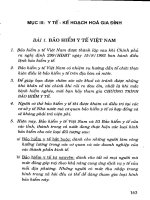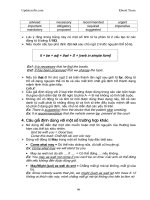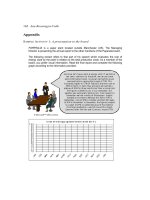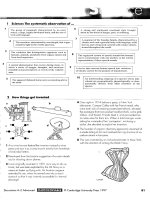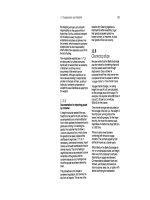Rapid GUI Development with QtRuby phần 8 pptx
Bạn đang xem bản rút gọn của tài liệu. Xem và tải ngay bản đầy đủ của tài liệu tại đây (374.25 KB, 14 trang )
F
ridays
CHAPTER 7. HOME STRETCH DEBUGGING A QTRUBY APPLICATION 78
• Minimal
• Hig
h
• Extensive
irb(main):007:0> Qt.debug_level = Qt::DebugLevel::High
=> 2
i
rb(main):008:0> w1 = Qt::Widget.new("MyWidget", nil)
classname == QWidget
:: method == QWidget
-> methodIds == []
candidate list:
No matching constructor found, possibles:
QWidget
*
QWidget::QWidget()
QWidget
*
QWidget::QWidget(QWidget
*
, const char
*
)
QWidget
*
QWidget::QWidget(QWidget
*
)
QWidget
*
QWidget::QWidget(QWidget
*
, const char
*
, Qt::WFlags)
setCurrentMethod()
ArgumentError: unresolved constructor call Qt::Widget
The output shows that Qt::Widget has four forms of initializer, none
o
f whi
ch fit the syntax we wer e trying.
Debug Channels
QtRuby also has a number of debug channels which can be turned
on or off. These let you look into the toolkit at runtime.
•
QTDB_NONE—No debug information
•
QTDB_AMBIGUOUS—unused
•
QTDB_METHODMISSING—unused
•
QTDB_CALLS—show method call information
• QTDB_GC—show garbage collection information
• QTDB_VIRTUAL—display virtual method override information
• QTDB_VERBOSE—unused
Report erratum
BOOKLEET ©
F
ridays
CHAPTER 7. HOME STRETCH DEBUGGING A QTRUBY APPLICATION 79
• QTDB_ALL—Turn on all debug channels
These
debug channels are set using:
Qt::Internal::setDebug(Qt::QtDebugChannel::QTDB_VIRT
UAL)
Report erratum
BOOKLEET ©
F
ridays
Chapter 8
Korundum
The KDE project is an open source Unix desktop environment. As
discussed in Section 2.1, A Little History, on page 5, it is heavily
based on Qt.
Many aspects of
KDE are extensions of things available in Qt, so
t
here are many Qt widgets that have been extended in KDE. Korun-
dum pr
ovides a set of Ruby bindings to these additional classes. In
other words, QtRuby is to Qt as Korundum is to KDE.
8.1 Installing Korundum
You need the Korundum package, available from the same location
as QtRuby.
First, the
KDE libraries must be installed. This can be accomplished
in a ve
ry simliar manner to the installation of
Qt as described in
Section 2.4, How to install Qt from source, on page 8. KDE is readily
available from most Linux distributions and from Fink on Mac OS.
KDE can be installed from source as well. To find out how to install
KDE, we recommend the excellent documentation at />Second, SMOKE must be configured to generate bindings for KDE.
One of t
he configuration options described in Section 3.3, Installing
QtRuby , on page 14 was with-smoke="qt". This needs to be changed to
with-smoke="qt kde". Alternatively, the whole option can be dropped,
as building bindings for both
Qt and KDE is the default behavior.
F
i
na
l
l
y, generate the Korundum bindings in the same way as you
did for QtRuby.
BOOKLEET ©
F
ridays
CHAPTER 8. KORUNDUM USING KORUNDUM 81
8.2 Using Korundum
Although using the Korundum classes is as easy as using QtRuby
clas
ses, you’ll need to change your progra ms slightly.
1. Change
require ’Qt’ to require ’Korundum’.
2
.
KDE classnames go into the KDE namespace, and the initial
K
is dropped. For example, the class KPopupMenu becomes
KDE::PopupMenu.
3. Us
e
KDE::Application instead of Qt::Application.
KDE::Application requires a little bit more setup than Qt::Application.
about = KDE::AboutData.new(
"appname"
,
"MyProgramName"
,
"1.0"
)
KDE::CmdLineArgs.init(ARGV, about)
app = KDE::Application.new()
w = KDE::DateTimeWidget.new
app.setMainWidget(w)
w.show
app.exec
As you can see, the KDE::Application class requires the initialization
of KDE
::AboutData and the KDE::CmdLi neArgs classes.
KDE classes
KDE comes with a large number of classes, gr o uped into libraries.
Some o
f these are:
•
kdeui—Widgets that provide standard user interface elements.
•
kdecore—Classes that aren’t widgets, but are very useful to
GUI programs.
• kio—A library of easy-to-use file management related classes.
Report erratum
BOOKLEET ©
F
ridays
CHAPTER 8. KORUNDUM DCOP—INTERPROCESS COMMUNICATION 82
• khtml—HTML rendering classes
•
DCOP—A library for interprocess communication among KDE
programs. We describe DCOP in more detail in the next section.
8.3 DCOP—Interprocess Communication
DCOP allows our Korundum programs to call remote methods in
o
ther
Korundum (or KDE) programs.
To make a method callable by
DCOP, define it in the same way we
KDE comes with a command line utility dcop
that can be used to inspect and call DCOP
methods in a running application.
defined a regular Qt slot.
require
'Korundum'
class MyWidget < KDE::Dialog
k_dcop
'QSize mySize()'
def initialize(parent=nil, name=nil)
super(parent,name)
end
def mySize()
return size()
end
end
In this case, we used the k_dcop declaration to make the mySize( )
metho
d remotely callable. We can then initialize a nd run the widget.
about = KDE::AboutData.new(
"app1"
,
"MyApplication"
,
"1.0"
)
KDE::CmdLineArgs.init(ARGV, about)
a = KDE::Application.new()
w = MyWidget.new
a.dcopClient.registerAs(
"app1"
,false)
a.setMainWidget(w)
Report erratum
BOOKLEET ©
F
ridays
CHAPTER 8. KORUNDUM DCOP—INTERPROCESS COMMUNICATION 83
app1
MyWidget
mySize()
dcopserver
app2
ref
call("mySize()")
640x384
Figure 8.1: DCOP Remote Method Call
w.show
a.exec
In a
second program, we can attempt to call this remote method.
require
'Korundum'
about = KDE::AboutData.new(
"app2"
,
"App2"
,
"1.0"
)
KDE::CmdLineArgs.init(ARGV, about)
a = KDE::Application.new()
ref = KDE::DCOPRef.new(
"app1"
,
"MyWidget"
)
res = ref.call(
"mySize()"
)
puts
"W: #{res.width} H: #{res.height}"
$ ruby ex_korundum_size_remote.rb
>>>> W: 640 H: 384
We illustrate this example in figure Figure 8.1 .
Report erratum
BOOKLEET ©
F
ridays
CHAPTER 8. KORUNDUM DCOP—INTERPROCESS COMMUNICATION 84
What’s going on here
What’s we’re seeing here is a lot of behind-the-scenes magic. First,
appl
ications wishing to use DCOP are considered DCOP clients and
need to register wit h the DCOP server (which runs automatically
after the KDE desktop start s). Clients can communicate with each
other via message calls which get sent to the server and dispatched
to the appropriate destination client. Some messages are one-way;
they are sent and the client continues without waiting for a reply.
Others are sent by clients who await a reply.
The KDE::Application class provides the method dcopClient( ) which
retu
rns a DCOPClient client connection to the server. The client can
attach( ) to or, de tach( ) from the server. It can also change its regis-
tration information with registerAs( ).
Objects within an application can use the
DCOPObject o bject to create
By default, a client attaches to the DCOP
server with the name of appname + "-" + pid.
This allows multiple applications with the same
name to utilize the
DCOP server. Changing the
registered name is as simple as using the
registerAs( ) method of DCOPClient class.
an interface via the DCOPClient for remote method calls. By using the
k_dcop syntax, this DCOPObject interface is aut o matically created for
us.
Finally, r emote applications can use
DCOPRef to create a connection
t
o a remote DCOPObject. The DCOPRef initializer has two arguments,
the name of the application to connect to (as was specified by the
DCOPClient registerAs( ) method), and the remote object to connect to
(as s
pecified by the objId( ) of the DCOPObject.
The
DCOPRef class can then use call( ) to call remote functions.
ref = DCOPRef.new(
"appname"
,
"objname"
)
ref.call(
"someFunction"
) # objname.someFunction
ref.call(
"someFunction()"
) #objname.someFunction
ref.call(
"someFunction()"
,
"arg"
) # objname.someFunction(arg)
Report erratum
BOOKLEET ©
F
ridays
CHAPTER 8. KORUNDUM DCOP—INTERPROCESS COMMUNICATION 85
For methods that have no r eturn value, there is the send( ) method.
ref = DCOPRef.new(
"appname"
,
"objname"
)
ref.send(
"someFunction"
,
"arg"
) # objname.someFunction(arg)
DCOP Signals
DCOP has signals, just like Qt. We can make remote signal/slot con-
nections in a very similiar manner. Consider the following program:
require
'Korundum'
class SignalWidget < KDE::Dialog
k_dcop_signals
'void mySizeSignal(QSize)'
slots
'timerSlot()'
def initialize(parent=nil, name=nil)
super(parent,name)
t = Qt::Timer.new(self)
connect(t, SIGNAL(
'timeout()'
), self,
SLOT(
'timerSlot()'
) )
t.start(5000)
end
def
timerSlot
p
uts
"emitting signal"
emit mySizeSignal(size())
end
end
about = KDE::AboutData.new(
"appname"
,
"MyApplication"
,
"1.0"
)
KDE::CmdLineArgs.init(ARGV, about)
a = KDE::Application.new()
w = SignalWidget.new
a.dcopClient.registerAs(
"appname"
,false)
a.setMainWidget(w)
Report erratum
BOOKLEET ©
F
ridays
CHAPTER 8. KORUNDUM DCOP—INTERPROCESS COMMUNICATION 86
w.show
a.exec
The c
orresponding remote application:
require
'Korundum'
class SlotWidget < KDE::Dialog
k_dcop
'void mySlot(QSize)'
def initialize(parent=nil, name=nil)
super(parent,name)
end
def mySlot(size)
puts
"mySlot called #{size}"
dispose
end
end
about = KDE::AboutData.new(
"remote"
,
"Remote"
,
"1.0"
)
KDE::CmdLineArgs.init(ARGV, about)
a = KDE::Application.new()
w = SlotWidget.new(
nil)
w.connectDCOPSignal(
"appname"
,
"SignalWidget"
,
"mySizeSignal(QSize)"
,
"mySlot(QSize)"
,
false)
a.setMainWidget(w)
a.exec
In e
xecuting these two programs, the follow logic occurs:
1. We create the
SignalWidget. Every five seconds it s internal timer
c
alls its slot timerSlot( ), which emits the DCOP signal mySizeSig-
nal( ).
2. We create the SlotWidget in a separate application. We a DCOP
Report erratum
BOOKLEET ©
F
ridays
CHAPTER 8. KORUNDUM SUMMARY 87
slot called mySlot( ) and connect SignalWidget’s signal to this slot.
3. We
run the program and watch as every five seconds the
DCOP
signal and slots get activated.
8.4 Summary
• Applications using KDE classes must use KDE::Application
instead of Qt::Application.
•
DCOP provides an interface for calling remote methods in run-
ni
ng ap
plications.
Report erratum
BOOKLEET ©
F
ridays
Appendix A
Event Method Map
Qt::Object
Events
Tablet
Drawing
Drag
and
Drop
Qt::TabletEvent
Qt::ResizeEvent
Qt::DragEnterEvent
Qt::HideEvent
Qt::ShowEvent
Qt::DragMoveEvent
Qt::DragLeaveEvent
Qt::DropEvent
Qt::PaintEvent
Qt::CloseEvent
Qt::CustomEvent
Qt::TimerEvent
Qt::ChildEvent
customEvent
childEvent
timerEvent
tabletEvent
dropEvent
dragLeaveEvent
dragMoveEvent
dragEnterEvent
paintEvent
hideEvent
showEvent
closeEvent
resizeEvent
Input
Method
Qt::KeyEvent
imEndEvent
imComposeEvent
imStartEvent
Tablet
Keyboard
Qt::TabletEvent
Qt::KeyEvent
tabletEvent
Event Type
Mouse
Qt::MouseEvent
mouseReleaseEvent
mouseMoveEvent
mouseDoubleClickEvent
mousePressEvent
Qt::Event
leaveEvent
enterEvent
Qt::WheelEvent
wheelEvent
keyReleaseEvent
keyPressEvent
Event Class Event Method Event Type Event Class Event Method
BOOKLEET ©
F
ridays
Appendix B
Resources
B.1 Web Resources
Qt
Trolltech’s homepage
KDE
KDE homepage
KDE Ruby Bindings Homepage
Brief introduction to QtRuby and Korundum
Qt Documentation
Online documentation for Qt and utilities
QtRuby Online Tutorial
Learn Qt and QtRuby online with this 14 step tutorial
QtRuby/Korundum at RubyForge
Rubyforge download site for QtRuby
C++ GUI Programming with Qt 3
Link to book website, with freely downloadable PDF.
BOOKLEET ©
F
ridays
APPENDIX B. RESOURCES BIBLIOGRAPHY 90
B.2 Bibliography
[BS04] Jasmin Blanchette and Mark Summerfield. C++ G
UI Pro-
gramming with Qt 3. Prentice Hall, Englewood Cliffs, NJ,
2004.
[TFH05] David Thomas, Chad Fowler, and Andrew Hunt. Pro-
gramming Ruby: The Pragmatic Programmers’ Guide. The
Pragmatic Programmers, LLC, Raleigh, NC, and Dallas,
TX, second edition, 2005.
Report erratum
BOOKLEET ©
Pragmatic Fridays
Timely and focused PDF-only books. Written by experts for people who need infor-
mation in a hurry. No DRM restrictions. Fre e updates. Immediate download. Visit
our web site to see what’s happening on Friday!
More Onli ne Goodness
QtRuby
Source code from this book and other resourc es. Come give us feedback, too!
Free Updates
Visit the link, identify your book, and we’ll create a new PDF containing the latest
content.
Errata and Suggestions
See su ggestions and known problems. Add your own. (The easiest wa
y to report an
errata is to click on the link at the bottom of the page.
Join the Community
Read our weblogs, join our online discussions, participate in our mailing list, inter-
act with our wiki, and benefit from the experience of other Pragmatic Programmers.
New and Noteworthy
Check out the latest pragmatic developments in the news.
Contact Us
Phone Orders: 1-800-699-PROG (+1 919 847 3884)
Online Orders: www.pragmaticprogrammer.com/catalog
Customer Service:
Non-English Versions:
Pragmatic Teaching:
Author Proposals:
BOOKLEET ©



